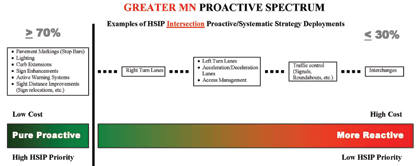U.S. Department of Transportation
Federal Highway Administration
1200 New Jersey Avenue, SE
Washington, DC 20590
202-366-4000
| << Implementation of Systemwide Improvements – Missouri | HSIP Project Identification | Development of SPFs for All State Routes and Intersections – Illinois >> |
Best for printing: [PDF] (1.9 MB)
To view PDF files, you can use the Acrobat® Reader®.
The data analysis conducted for the development of Minnesota’s original Strategic Highway Safety Plan (SHSP) in 2004 indicated a large percentage of severe crashes were occurring on local roadways. All Highway Safety Improvement Program (HSIP) funding was managed by eight Area Transportation Partnerships (ATP)1, and a small portion of the funding was allocated to local road safety improvements. To ensure the state was using HSIP funding in the best way possible, Minnesota restructured the program to provide funding for local agencies in Greater Minnesota (areas not within the Minneapolis-St. Paul metro area) and developed funding goals for proactive and reactive improvements.
Minnesota distributes HSIP funding to each district based on the proportion of fatal and serious injury crashes occurring in the district. The district funds are then allocated to local roads and state highways based on the proportion of fatal and serious injury crashes occurring on the corresponding roadways. The split ranges from 28 percent to state highways and 72 percent to local roadways in the Metropolitan District, to a 50/50 split in District 1 (average across districts is 35 percent to state highways and 65 percent to local roadways).
In Minnesota approximately 70 percent of all crashes occur in urban areas; however, approximately 70 percent of the fatal crashes occur in rural areas. To address the inherent differences in the safety issues of urban and rural areas, Minnesota has established two separate goals to guide safety investments:
Minnesota developed a “proactive spectrum” decision support tool for use in project selection, which has been in use since 2007. The spectrum ranges from proactive low-cost projects (e.g. pavement markings, rumble strips, lighting, sign enhancements, etc.) to reactive/high-cost improvements (e.g., interchanges, roadway realignments, etc.). The proactive improvements are focused on improving the safety of the system overall, rather than focusing on a high crash location.

Projects are selected for funding through a competitive selection process. Proactive projects are prioritized using a point system based on factors such as whether the project meets the intent of the SHSP, fatal and serious injury crashes per mile, cost per mile or per intersection, and traffic levels. Additional points are awarded if the location was identified in the High Risk Rural Roads Program or the Five Percent report. Reactive projects are prioritized based on the project’s benefit-cost ratio and other factors. The objective of this process is to prioritize and fund safety projects with the greatest impact on reducing fatal and serious injury crashes.
Minnesota has successfully shifted the focus of its HSIP to a proactive approach through the development of the “Proactive Spectrum.” This enables the state to focus on projects with the greatest potential impact on safety.
The proportion of funding spent on proactive improvements has been increasing over the last few years. Of the projects programmed for fiscal year 2010-2011, almost 90 percent were proactive. Since 2007, Minnesota has funded safety projects on local and state roads to implement over: 6,714 miles of 6-inch wide edge lines; 80 miles of edge line rumble strips; 594 miles of edge line rumble stripes; 236 rural intersections with street lighting; 1,347 curves with chevron signing; and 230 miles of cable median barrier.
Julie Whitcher
Minnesota Department of Transportation
651-234-7019
julie.whitcher@state.mn.us
| << Implementation of Systemwide Improvements – Missouri | HSIP Project Identification | Development of SPFs for All State Routes and Intersections – Illinois >> |
